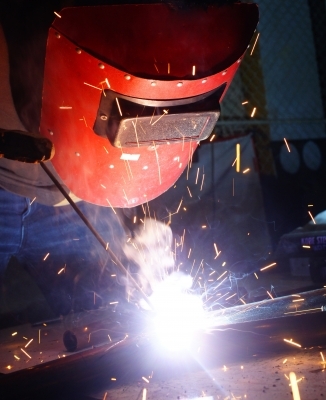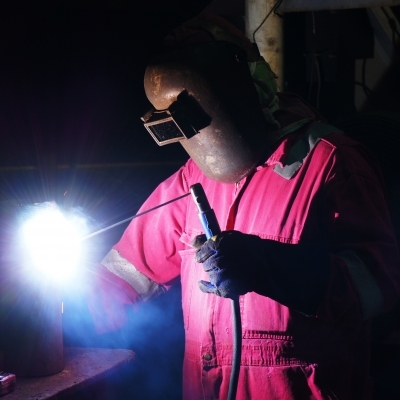The Unique Safety Needs of Welders
Practically any industrial production job involves some degree of risk to workers, and welding certainly provides its share. The application of high-temperature torches onto metal surfaces inevitably creates dangerously bright light, hot sparks and flying debris. As a result, welders must use specific types of clothing and equipment to meet their unique safety needs. Let’s look at some of these modes of protection.
Eyes and face – The most obvious threat to a welder involves hot sparks, bits of metal or other debris flying up into the face, eyes or hair. For this reason alone, a welder would always need to wear protective headgear that includes both a faceguard and a helmet. Additionally, however, welders must protect their eyes against dangerous frequencies of ultraviolet light that can cause serious eye damage or even blindness after prolonged or repeated exposures.
While many construction workers might simply don a pair of safety goggles (tinted or un-tinted) to keep foreign matter and bright sunlight out of their eyes, welders must be equipped with a specially designed welding hood that includes ANSI-certified shading against the hazardous UV frequencies generated by their work. Since different types of welding torches generate different degrees of UV, welders should select a model that includes protection against their specific type of job or project, based on an IR scale of 1.5 (minimum shading) to 14 (maximum shading).
Some models, such as the Pyramex Auto Darkening Helmet, can provide IR shades ranging from #9 to #13. This design also includes plenty of interior room for a respirator if needed.
Welders must use suitable eye and face protection against blinding, scorching sparks.
Head and ears – While a full-scale welding hood may protect the entire head, welders using just a faceguard may need to add a separate helmet to protect their hair from sparks. At the same time, however, they should also worry about flying debris entering the ear canals and causing blockages, infections or serious damage. Earplugs can close off the ear canals against this threat, while earmuffs such as the Pyramex PM1010 also protect the outer ear, provided that you can fit them underneath your helmet. These products have the added advantage of protecting your hearing in a noisy manufacturing or construction environment.
Hands and feet – A welder’s hands come closer to the source of dangerous sparks and flying debris than any other part of his body, so thick, fire-resistant gloves should be on every welder’s essential equipment list. Choose gloves specially designed for welding and other high-heat applications, such as Goatskin Tig Leather Welders or Kevlar Wool Lined 14-inch Gloves.
At the same time, however, keep in mind that sparks may also fall downward toward the feet, igniting ordinary cloth shoelaces, or a heavy piece of substrate may slip and drop onto them, causing serious injury. Leather boots with steel-reinforced toes can help protect against both of these dangers, while shoe covers can keep sparks off of laces.
Other considerations – Even if welders own all of the above items, they may need to take additional measures to protect themselves when welding. Gulfport Indura coveralls or similarly flame-resistant garments can reduce the risk of a stray spark igniting on the shirt or pants, for example. Heavy organics such as wool and cotton always make better choices than synthetics, which tend to melt when ignited.
Pants should always fit over boots instead of tucking inside them so debris or sparks cannot fall inside the boots. The sleeves should extend over the arms at all times.
Don’t forget the flame-resistant coveralls!
When properly used by workers (and properly required by management), these protective items can make all the difference between tragedy and “just another day at the office,” so make the effort to safeguard yourself or your employees. Happy welding!
William Reynolds has worked as a freelance copywriter since 1997. William specializes in website content, ghost-blogging, print marketing content and audio/video scripts for providers of health and safety products such as Miracle-Ear.
(Images courtesy of gameanna and suwatpo /FreeDigitalPhotos.net)

